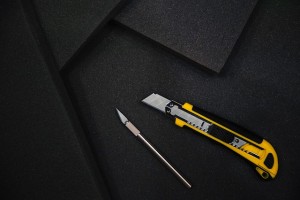 Print a Sign-In Sheet | Spanish Version
Print a Sign-In Sheet | Spanish Version
We frequently have a need in the workplace and at home to use knives. We cut binding off boxes of paper. We open containers and cut meat products, ropes, material, etc. However, we don’t always do this safely. Observe someone using a knife and note how often that person risks being injured by cutting toward himself or herself. For example, when cutting a loaf of bread, it is common for a person to hold the bread near his chest and cut toward his body when slicing. Sometimes when cutting a rope, we bend the rope into a loop and insert the knife, cutting edge facing upward, into the loop. This is not a good idea! When the knife is pulled up through the rope, the force of the cutting action can bring it to the face or other body parts.
An unwise, but common use of box knives is to reach across the box and draw the knife toward you. A rule of thumb is to “always cut away from you, and you’ll never cut yourself.” Another great truth is, “a sharp knife is a safer knife.” This gives you greater control of the blade. When a heavy force is applied, the blade often cuts deeper than intended, sometimes into your flesh.
Hand and arm protection is also available for occupations that require the use of knives. Specialty gloves protect hands and arms from cuts and punctures. Smart workers wear this protection consistently.
The bottom line is to practice good knife safety:
- Only use sharp knives.
- Use the right knife for the job.
- Wear cut-resistant gloves when appropriate.
- Always cut away from your body.
KEMI does not assume liability for the content of information contained herein. Safety and health remain your responsibility. This information is to be used for informational purposes only and not intended to be exhaustive or a substitute for proper training, supervision, or manufacturers’ instructions/recommendations. KEMI, by publication of this information, does not assume liability for damage or injury arising from reliance upon it. Compliance with this information is not a guarantee or warranty that you will be in conformity with any laws or regulations nor does it ensure the absolute safety of any person, place, or object, including, but not limited to, you, your occupation, employees, customers, or place of business.

